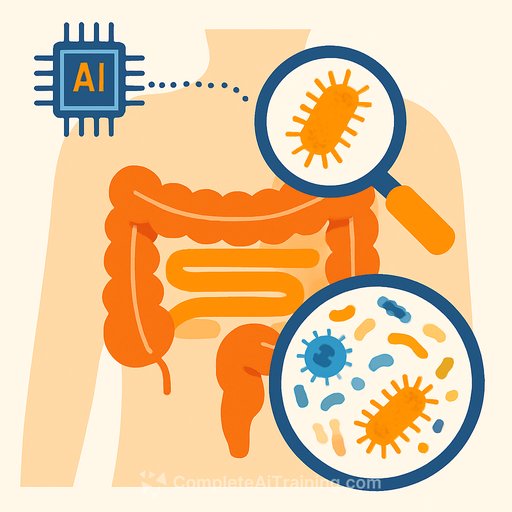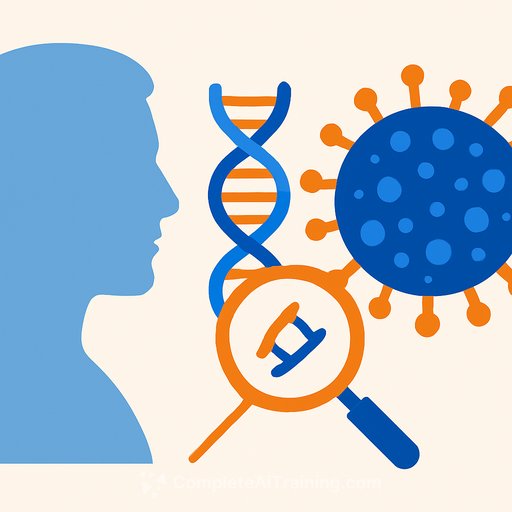AI maps how a narrow-spectrum antibiotic hits E. coli tied to Crohn's-months instead of years
Broad-spectrum antibiotics can worsen gut symptoms by wiping out helpful microbes along with the harmful ones. A new molecule, enterololin, offers a more precise path: it suppresses Escherichia coli linked to Crohn's disease flare-ups while sparing much of the microbiome.
Researchers at MIT CSAIL and McMaster used a generative AI model to pinpoint how enterololin works-a step that typically stalls programs for years. Here, it took months, and the lab work lined up with the model's predictions.
Why this matters
Narrow-spectrum antibiotics aim to treat infection without destabilizing the microbiome. That's particularly relevant for inflammatory bowel disease, where microbiome disruption can prolong flares.
Precision strategies also support antimicrobial stewardship. Reducing unnecessary collateral damage may help slow resistance pressure across microbial communities. For broader context on resistance, see the WHO overview on antimicrobial resistance here.
Key results at a glance
- Enterololin improved outcomes in mouse models of Crohn's-like inflammation.
- The drug selectively targeted E. coli associated with flares, with less impact on other gut microbes compared to vancomycin.
- Using AI to generate a mechanism-of-action hypothesis cut the mechanism-finding timeline to about six months.
How the AI accelerated mechanism-of-action
The team used DiffDock, a generative diffusion model for molecular docking, to predict how enterololin binds within protein pockets. Instead of scoring many poses with hand-tuned rules, DiffDock iteratively refines probabilistic guesses to converge on a likely binding mode.
Within minutes, the model pointed to LolCDE, an essential lipoprotein transport complex in certain bacteria, as the target. That gave the lab a concrete hypothesis to test, saving cycles of trial-and-error.
What the experiments showed
- Evolved resistance mapping: Enterololin-resistant E. coli mutants carried DNA changes in lolCDE, matching the model's prediction.
- Transcriptomics: RNA-seq showed gene-expression shifts consistent with disrupted lipoprotein transport.
- CRISPR knockdowns: Reducing expression of the predicted target sensitized cells in line with the hypothesized mechanism.
Convergence across evolution experiments, RNA-seq, and CRISPR pointed to the same mechanism-interference with lipoprotein transport via LolCDE.
Bench-to-impact timeline and costs
Mechanism-of-action studies often run 18-24 months and burn significant budget. By using AI as a hypothesis engine and focusing validation, the team compressed that window to about six months at a fraction of the usual cost.
Translation and next steps
Enterololin is early but moving forward. Stokes' spinout, Stoked Bio, licensed the compound and is optimizing it for potential human use. Derivatives are being explored against resistant pathogens such as Klebsiella pneumoniae.
If preclinical work continues to hold, clinical trials could begin in the coming years.
Implications for your research team
- Treat docking as hypothesis generation, not ground truth. Use generative models to narrow targets quickly, then design focused assays.
- Pair predictions with a fast validation loop: resistance evolution + sequencing, transcriptomics, and CRISPR perturbations.
- Prioritize narrow-spectrum candidates in microbiome-sensitive indications to reduce collateral effects and downstream resistance pressure.
- Document and release data/code where possible to accelerate replication and downstream optimization.
Open data and code
The researchers posted sequencing data to public repositories and released DiffDock-L code on GitHub. Explore DiffDock here: github.com/gcorso/diffdock.
Quotes from the team
"The problem isn't finding molecules that kill bacteria in a dish. A major hurdle is figuring out what those molecules actually do inside bacteria," says Jon Stokes of McMaster and the Jameel Clinic.
"AI can also provide mechanistic explanations, which are critical for moving a molecule through the development pipeline," adds MIT Professor Regina Barzilay.
For skills and tooling
If you're building similar capabilities in your lab or team, you can browse current AI courses and tools relevant to R&D workflows here: Complete AI Training - Latest AI Courses.
Paper: "Discovery and artificial intelligence-guided mechanistic elucidation of a narrow-spectrum antibiotic."
Your membership also unlocks:






